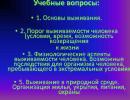USE. Biology. Solving tasks of increased and high level of complexity. How to get the maximum score. Kalinova G.S. How exam assignments in biology are evaluated
The biology exam is one of the selective ones and those who are confident in their knowledge will take it. The exam in biology is considered a difficult subject, as knowledge accumulated over the years of study is tested.
The tasks of the USE in biology are selected of different types, for their solution, confident knowledge of the main topics is required school course biology. Based demos teachers have developed more than 10 test tasks on each topic.
See the topics that you need to study when completing assignments from FIPI. For each task, its own algorithm of actions is prescribed, which will help in solving problems.
There are no changes in KIM USE 2020 in biology.
The structure of the USE tasks in biology:
- Part 1- these are tasks from 1 to 21 with a short answer, up to about 5 minutes are allotted for completion.
Advice: Read the wording of the questions carefully.
- Part 2- these are tasks from 22 to 28 with a detailed answer, approximately 10-20 minutes are allotted for completion.
Advice: express your thoughts in a literary way, answer the question in detail and comprehensively, give a definition to biological terms, even if this is not required in the assignments. The answer should have a plan, not write in solid text, but highlight points.
What is required of the student in the exam?
- Ability to work with graphic information (diagrams, graphs, tables) - its analysis and use;
- Multiple choice;
- Establishing compliance;
- Sequencing.
Points for each task in USE biology
In order to get the highest grade in biology, you need to score 58 primary points, which will be converted to one hundred on the scale.
- 1 point - for 1, 2, 3, 6 tasks.
- 2 points - 4, 5, 7-22.
- 3 points - 23-28.
How to Prepare for Biology Tests
- repetition of the theory.
- Proper allocation of time for each task.
- Solving practical problems several times.
- Checking the level of knowledge by solving tests online.
Register, study and receive high score!
USE. Biology. Solving tasks of increased and high level of complexity. How to get the maximum score. Kalinova G.S.

M.: 2017. - 128 p.
The proposed manual characterizes the main types of tasks with a detailed answer of part 2 used in the USE, provides answers from graduates and comments on their assessment. Particular attention is paid to the analysis of tasks that caused the greatest difficulties, as well as typical mistakes made by graduates in different years. For training and self-preparation for the exam, tasks are offered with a detailed answer of various levels of complexity for all meaningful blocks (34 - 40). At the end of the manual, there are sample answers with evaluation criteria. The manual is addressed, first of all, to students and applicants who will take the exam in biology; it will also be of interest to school teachers, methodologists and parents.
Format: pdf
The size: 2.8 MB
Watch, download:drive.google
CONTENT
INTRODUCTION 4
I. MAIN TYPES OF TASKS PART 2 WITH A FREE DETAILED ANSWER AND THE METHOD OF THEIR EVALUATION 7
II. TYPICAL ERRORS OF GRADUATES REVEALED DURING THE ANALYSIS OF TASKS WITH A FREE DETAILED ANSWER (PART 2) 20
III. TASKS WITH A DETAILED ANSWER FOR INDEPENDENT SOLUTION 45
IV. ANSWERS TO TASKS WITH A DETAILED ANSWER FOR INDEPENDENT SOLUTION 63
Of great importance for the certification of school graduates and their selection to universities with the help of control measuring materials of the Unified State Examination are tasks with a free answer. Unlike tasks with a choice of answers, when performing tasks with a free answer, a hint or guessing the correct answer is excluded. Students must independently formulate the answer to the question posed. Tasks of this type are great importance to identify the level of formation of graduates not only knowledge, but also learning skills, to differentiate students according to the level of their preparation and selection to higher educational establishments biological profile. The inclusion of tasks with a detailed answer in the examination paper makes it possible not only to evaluate the educational achievements of the examinees, the depth of their knowledge, but also to reveal the logic of their reasoning. These tasks allow you to get objective results during the exam.
When performing tasks with a detailed answer, the degree of mastering by students of various types is controlled. learning activities, certain skills: to characterize, recognize, define, compare, explain and compare biological objects, processes and phenomena, establish cause-and-effect relationships, generalize, justify, draw conclusions, apply theoretical knowledge to solve biological problems, to think logically. When performing these tasks, the examinees have the opportunity to quite fully, deeply and competently express their thoughts, demonstrate the depth of knowledge in biology.
| the date | USE |
|---|---|
| early period | |
| March 20 (Fri) | geography, literature |
| March 23 (Mon) | Russian language |
| March 27 (Fri) | math B, P |
| March 30 (Wed) | foreign languages(except for the "Speaking" section), biology, physics |
| April 1 (Wed) | |
| April 3 (Fri) | social science, informatics and ICT |
| April 6 (Mon) | history, chemistry |
| April 8 (Wed) | reserve: geography, chemistry, informatics and ICT, foreign languages (Speaking section), history |
| April 10 (Fri) | reserve: foreign languages (except for the "Speaking" section), literature, physics, social science, biology |
| April 13 (Mon) | reserve: Russian language, mathematics B, P |
| main stage | |
| May 25 (Mon) | geography, literature, informatics and ICT |
| May 28 (Thu) | Russian language |
| June 1 (Mon) | math B, P |
| June 4 (Thurs) | history, physics |
| June 8 (Mon) | social science, chemistry |
| June 11 (Thu) | foreign languages (except for the "Speaking" section), biology |
| June 15 (Mon) | foreign languages (section "Speaking") |
| June 16 (Tue) | foreign languages (section "Speaking") |
| June 18 (Tue) | reserve: history, physics |
| June 19 (Fri) | reserve: geography, literature, informatics and ICT, foreign languages (section "Speaking") |
| June 20 (Sat) | reserve: foreign language (except for the "Speaking" section), biology |
| June 22 (Mon) | reserve: Russian |
| June 23 (Tue) | reserve: social science, chemistry |
| June 24 (Wed) | reserve: history, physics |
| June 25 (Thu) | reserve: mathematics B, P |
| June 29 (Mon) | reserve: in all subjects |
In 2018, more than 133 thousand people took part in the USE in biology, which is slightly more than the number of participants in the exam in 2017 (111,748 people), 2016 (126,006) and 2015 (122,936). The biology exam is traditionally in demand and is one of the five most popular final exams optionally. It is chosen by biology-motivated graduates entering medical, veterinary, agricultural universities, psychological and biological faculties universities, academies and institutes of physical culture and sports and a number of other universities.
In 2018, the average test score was 51.4. Its slight decrease compared to the previous year is primarily due to a decrease in the share of participants in the test score range of 61–80 (by 2.26%) and an increase in the share of participants in the range of 41–60 (by 3.26%). At the same time, there is a persistent downward trend in the number of participants with results in the range of 81–100. The reduction in the share of high-scorers can be explained by a set of measures to improve the quality of verification of detailed answers by experts of the subject commissions of the regions, as well as the inclusion in part 2 of the KIM of new plots of a specific, contextual, practice-oriented nature that required clear argumentation, and not the reproduction of general or particular knowledge on the subject. This allowed for a better differentiation of participants with high test scores.
The minimum test score in 2018, as in previous years, was 36 points, and the primary score was 16 points. The share of USE participants in biology who did not score minimum quantity points in 2018 amounted to 17.4%. Compared to 2017, the proportion of participants who scored test scores in the range of 41-60 was 40.6% (in 2017 - 37.3%), and in the range of 61-80 was 25.6% (in 2017 - 27.9%.
In 2018, 48 graduates completed all the tasks of the examination paper and scored 100 points, which amounted to 0.04% of the total number of USE participants. The data obtained indicates, on the one hand, a rather high level of complexity of the KIM USE 2018 model and, on the other hand, the availability of tasks, which is confirmed by the distribution of primary and test scores of participants.
More detailed analytical and methodological USE materials 2018 are available at the link.
Our website contains about 5500 assignments for preparing for the exam in biology in 2018. Overall plan examination paper is presented below.
PLAN OF THE EXAMINATION WORK OF THE USE IN BIOLOGY 2019
Designation of the level of difficulty of the task: B - basic, P - advanced, C - high.
Content elements and activities to be checked |
Task difficulty level |
The maximum score for completing the task |
| Exercise 1. Biological terms and concepts. Schema completion | ||
| Task 2. Biology as a science. Methods of scientific knowledge. Levels of organization of the living. Working with a table | ||
| Task 3. Genetic information in a cell. Chromosomal set, somatic and sex cells. Solving a biological problem | ||
| Task 4. The cell as a biological system. Life cycle cells. Multiple choice (with pic. and without pic.) | ||
| Task 5. The cell as a biological system. Cell structure, metabolism. The life cycle of a cell. Establishing correspondence (with and without fig.) | ||
| Task 6. Mono- and dihybrid, analyzing crossing. Solving a biological problem | ||
| Task 7. The body as a biological system. Selection. Biotechnology. Multiple choice (without pic. and with pic.) | ||
| Task 8. The body as a biological system. Selection. Biotechnology. Establishing correspondence (with and without fig.) | ||
| Task 9. Diversity of organisms. Bacteria, Mushrooms, Plants, Animals, Viruses. Multiple choice (with pic. and without pic.) | ||
| Task 10. Diversity of organisms. Bacteria, Mushrooms, Plants, Animals, Viruses. Establishing correspondence (with and without fig.) | ||
| Task 11. Diversity of organisms. The main systematic categories, their subordination. Sequencing | ||
| Task 12. Human organism. Human hygiene. Multiple choice (with pic. and without pic.) | ||
| Task 13. Human organism. Establishing correspondence (with and without fig.) | ||
| Task 14. Human organism. Sequencing | ||
| Task 15. The evolution of living nature. Multiple choice (work with text) | ||
| Task 16. The evolution of living nature. Human Origins. Matching (not shown) | ||
| Task 17. Ecosystems and their inherent patterns. Biosphere. Multiple choice (not pictured) | ||
| Task 18. Ecosystems and their inherent patterns. Biosphere. Matching (not shown) | ||
| Task 19. General biological patterns. Sequencing | ||
| Task 20. General biological patterns. Man and his health. Work with the table (with and without fig.) | ||
| Task 21. Biological systems and their patterns. Data analysis, in tabular or graphic form | ||
| Task 22 (C1). Application of biological knowledge in practical situations (practice-oriented task) | ||
| Task 23 (C2). Task with the image of a biological object | ||
| Task 24 (C3). Task for the analysis of biological information | ||
| Task 25 (С4). Generalization and application of knowledge about man and the diversity of organisms. | ||
| Task 26 (C5). Generalization and application of knowledge in a new situation about the evolution of the organic world and environmental patterns in a new situation | ||
| Task 27 (C6). Solving problems in cytology on the application of knowledge in a new situation. | ||
| Task 28 (C7). Solving problems in genetics on the application of knowledge in a new situation |
Correspondence between the minimum primary scores and the minimum test scores of 2019. Order on amendments to Appendix No. 1 to the order of the Federal Service for Supervision in Education and Science.
The demo is for in order to enable any participant in the examination and the general public to get an idea of the structure of the examination paper, the number and form of tasks, as well as their level of complexity. The given criteria for assessing the performance of tasks with a detailed answer, included in demo version examination work, will allow you to get an idea of the requirements for the completeness and correctness of writing a detailed answer. This information gives graduates the opportunity to develop a strategy for preparing for the biology exam.
Work instructions
The examination paper consists of two parts, including 32 tasks. Part 1 contains 28 short answer tasks, part 2 contains 4 long answer tasks.
3 hours (180 minutes) are allotted to complete the examination paper in biology.
Answers to tasks 1-22 are written as one digit, which corresponds to the number of the correct answer. Write this number in the answer field in the text of the work.
Answers to tasks 23-28 are written as a sequence of numbers in the answer field in the text of the work.
For tasks 29-32, a detailed answer should be given.
The points you get for completed tasks are summed up.
Try to complete as many tasks as possible and score the most points.
Characteristics of the structure and content of KIM
The work includes 32 tasks and consists of two parts.
Part 1 contains 28 tasks with a short answer: 22 tasks of the basic level of complexity with a single digit answer corresponding to the number of the correct answer; 6 tasks of an increased level of complexity, of which 2 with the choice and recording of three correct answers out of six, 3 for establishing the correspondence between the elements of two information series (including the task for including terms and concepts omitted in the text, for correlating the morphological features of the organism or its individual organs with the proposed models according to a given algorithm), 1 to determine the sequence of biological processes, phenomena, objects.
Part 2 contains 4 tasks with a detailed answer, of which: 1 of an increased level of complexity for working with text, involving the use of information from the text of contextual knowledge to answer the questions posed; the rest of the high level of complexity: 1 for the analysis of statistical data presented in tabular form; 2 on the application of biological knowledge to solve practical problems.
The distribution of tasks of the examination paper by parts and types of tasks, taking into account the maximum primary score of each part and the work as a whole, is given in Table 1.
The system for evaluating the performance of individual tasks and the examination work as a whole.
For the correct execution of each of the tasks 1-22, 1 point is given.
Otherwise, 0 points.
For the correct execution of each of the tasks 23-27, 2 points are given.
For answers to tasks 23 and 24, 1 point is given if the answer contains any two numbers presented in the answer standard, and 0 points in all other cases. If the examinee indicates more characters in the answer than in the correct answer, then 1 point is reduced for each extra character (up to 0 points inclusive).
For the answer to task 25, 1 point is given if one mistake is made, and 0 points if two or more mistakes are made.
For answers to tasks 26 and 27, 1 point is given if any one position of the answer contains a different character than that presented in the standard answer, and 0 points in all other cases.
For the complete correct completion of task 28, 3 points are awarded; 2 points if any one position of the answer does not contain the same character that is presented in the standard answer; 1 point is given if any two positions of the answer contain characters other than those presented in the answer standard, and 0 points in all other cases.
Tasks 29-32 are evaluated depending on the completeness and correctness of the answer.
The maximum primary score for completing the entire work is 46.
Changes in the OGE 2016 in biology - NO changes.
Testing at the Independent Diagnostic Center of the educational site "Kursoteka".
Checking and evaluation of tests of the trial version is carried out automatically. Verification and evaluation of detailed answers is carried out by experienced teachers in accordance with the criteria and recommendations of the "Federal Service for Supervision in Education and Science Russian Federation". Our teachers will correct your mistakes, give a complete and qualified analysis of errors and inaccuracies, if you wish, they will conduct an online consultation with you on the work performed and give special recommendations for eliminating errors and shortcomings. Tasks with detailed answers that are checked manually by teachers , are paid - RUB 198. The verification period is from 1 to 3 days.
The description of the exam is taken from the official website of FIPI http://www.ctege.info/demoversii-oge-2016/demoversiya-oge-2016-po-biologii.html
Future pharmacists, doctors and agronomists are preparing for the USE-2017 in biology. The subject is quite popular, as it is necessary for admission to many liberal arts universities. Therefore, the closer March 2017 approaches, the more the hype around state biology testing becomes. In the review, we will analyze the main structure of CIMs, currently known innovations and educational materials to help prepare for the state exam. All this will help the children adequately meet the realities of the biology exam.
the date of the
The early round traditionally starts in March, and the main one will take place in June.
- Early stage - March 22.
- The main period is June 15th.
- Reserve windows are April 5, June 21 and 30.
The main changes in the exam in biology 2017
If for the most part in other subjects there are no innovations and are not planned, then biology has undergone quite serious changes. Here is their list:
- the duration of the exam has increased - 210 minutes instead of the previous 180;
- the number of questions has been reduced from 40 to 28;
- tasks with one answer have practically disappeared;
- the maximum primary score has been reduced - now it is 59, not 61;
- appeared the new kind questions that require working with illustrations, diagrams and graphs.
What does the new structure of KIM in biology look like?
To understand the structure of the control and measuring material, we turn to USE demos in biology 2017.
The first block of KIM includes 21 tasks, each of which requires a short answer in the form of a few numbers or one or more words. The questions are pretty simple. To cope with them, you need to know the basics of biology. For example, task number 3 will require you to name the number of fish spermatozoa, and two columns in question number 5 will require you to establish a correspondence between the processes and stages of energy metabolism. Interestingly, questions 3, 4, 9, 12, 20, 21 have two options. Therefore, the subject will be able to choose the version of the task that seems to him the easiest. For those who strive to get the maximum scores on the exam in biology, FIPI has prepared a complex block of tasks, consisting of 7 questions. They will require not only an answer, but also a detailed explanation of them. In other words, the examinee must state on paper the course of his thoughts and give detailed arguments in favor of his decision. Only the most prepared high school students and applicants will be able to cope with such questions.
Criteria for assessing the exam in biology 2017
There are no exact criteria yet. It is only known that the maximum primary score cannot be higher than 59, and the number of minimum points that the subject must score in order to successfully pass the test work is 36.
Points are earned by successfully solving test tasks. Here's what the maximum "reward" for questions looks like:
- 1 point: 1, 3, 6;
- 2 points: 2, 4, 5, 7 - 22;
- 3 points: 23 - 28.
For errors or incomplete answers in questions 2, 4, 5, 7 - 28 points may be reduced.

Afterword
This is what a brief tour of reality looks like single exam in biology. The number of tasks has significantly decreased, testing has become much more interesting, and the time for work has increased by half an hour. Having this information will help future graduates high school and applicants to adequately prepare for the Unified State Exam!






